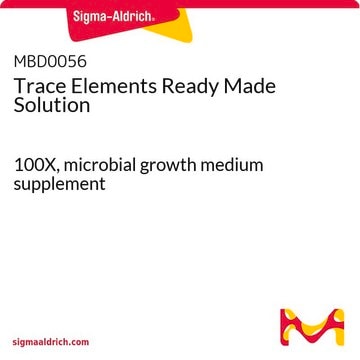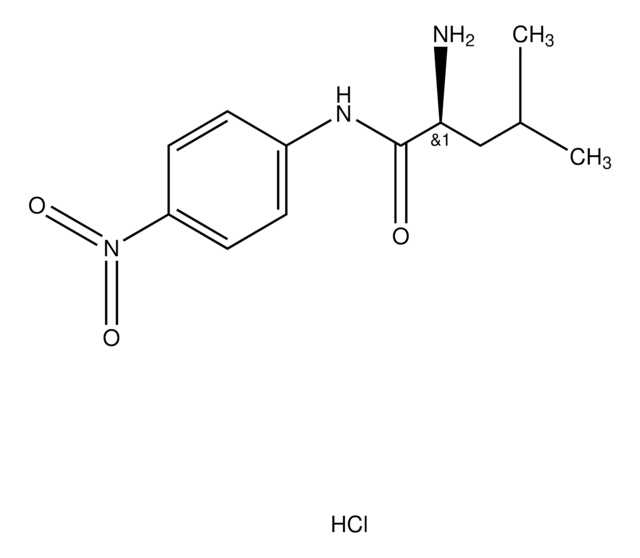M6030
M9, Minimal Salts, 5X
powder, minimal microbial growth medium
Synonym(s):
M9 media
Sign Into View Organizational & Contract Pricing
All Photos(1)
About This Item
UNSPSC Code:
12352302
NACRES:
NA.85
Recommended Products
grade
for molecular biology
Quality Level
sterility
non-sterile
form
powder
composition
KH2PO4, 15 g/L
NaCl, 2.5 g/L
Na2HPO4, 33.9 g/L
NH4Cl, 5 g/L
application(s)
food and beverages
storage temp.
room temp
suitability
nonselective for Escherichia coli
nonselective for coliforms
General description
M9 Minimal Salts is a highly-referenced microbial growth medium used for the cultivation of E. coli. This buffered minimal microbial medium contains only salts and nitrogen, so it is traditionally supplemented with glucose, amino acids and vitamins as needed.
Application
M9, Minimal Salts, 5X has been used:
- in a selective agar medium for the isolation of sulphate reducing bacteria
- in GMML minimal media to propagate phage-resistant DH10B cells
- in M9 minimal medium which is used for cell motility assay
Features and Benefits
M9 powder provides:
- Standard formulation
- A budget-friendly alternative to liquid
Preparation Note
1. Dissolve 56.4 g in 1L of distilled water.
2. Autoclave for 15 minutes at 121°C.
This convenient 5× concentrate can be stored and diluted as needed to prepare 5 L of 1× M9 minimal salts.
For M9 minimal medium:
1. Aseptically dilute 200 ml of M9 minimal salts, 5× concentrate with 800 ml of sterile water. If necessary, cool to 45-50°C.
2. Aseptically add 20 ml of sterile 1 M glucose and 2 ml of sterile 1 M magnesium sulfate to prepare 1 L of M9 minimal medium.
3. If desired, aseptically add 0.1 ml of 1 M sterile calcium chloride to the M9 minimal medium. The M9 minimal medium may also be supplemented with the appropriate amino acids.
2. Autoclave for 15 minutes at 121°C.
This convenient 5× concentrate can be stored and diluted as needed to prepare 5 L of 1× M9 minimal salts.
For M9 minimal medium:
1. Aseptically dilute 200 ml of M9 minimal salts, 5× concentrate with 800 ml of sterile water. If necessary, cool to 45-50°C.
2. Aseptically add 20 ml of sterile 1 M glucose and 2 ml of sterile 1 M magnesium sulfate to prepare 1 L of M9 minimal medium.
3. If desired, aseptically add 0.1 ml of 1 M sterile calcium chloride to the M9 minimal medium. The M9 minimal medium may also be supplemented with the appropriate amino acids.
Reconstitution
Make a 5x concentrated stock solution by stirring to suspend 56.4g powder in 1L water. Autoclave for 15 minutes at 121°C to sterilize. Allow to cool before making additions, such as antibiotics (if desired).
Dilute the 5x M9 concentrated stock to a 1x working solution by adding 200mL 5x M9 stock to 800mL sterile water. If needed, allow to cool before making additions, such as antibiotics (if desired).
Dilute the 5x M9 concentrated stock to a 1x working solution by adding 200mL 5x M9 stock to 800mL sterile water. If needed, allow to cool before making additions, such as antibiotics (if desired).
related product
Product No.
Description
Pricing
Storage Class Code
11 - Combustible Solids
WGK
WGK 1
Flash Point(F)
Not applicable
Flash Point(C)
Not applicable
Personal Protective Equipment
dust mask type N95 (US), Eyeshields, Gloves
Certificates of Analysis (COA)
Search for Certificates of Analysis (COA) by entering the products Lot/Batch Number. Lot and Batch Numbers can be found on a product’s label following the words ‘Lot’ or ‘Batch’.
Already Own This Product?
Find documentation for the products that you have recently purchased in the Document Library.
Customers Also Viewed
Matthew J Culyba et al.
PLoS genetics, 14(6), e1007405-e1007405 (2018-06-02)
Biochemical pathways are often genetically encoded as simple transcription regulation networks, where one transcription factor regulates the expression of multiple genes in a pathway. The relative timing of each promoter's activation and shut-off within the network can impact physiology. In
Intestinimonas butyriciproducens gen. nov., sp. nov., a butyrate-producing bacterium from the mouse intestine.
Klaring K
International Journal of Systematic and Evolutionary Microbiology, 63, 4606-4612 (2013)
Omri M Finkel et al.
Nature, 587(7832), 103-108 (2020-10-02)
Plants grow within a complex web of species that interact with each other and with the plant1-10. These interactions are governed by a wide repertoire of chemical signals, and the resulting chemical landscape of the rhizosphere can strongly affect root
An expanded genetic code with a functional quadruplet codon.
Anderson JC
Proceedings of the National Academy of Sciences of the USA, 101(20) (2004)
Amar Ghodasara et al.
Nucleic acids research, 45(13), 8116-8127 (2017-06-14)
Balancing protein expression is critical when optimizing genetic systems. Typically, this requires library construction to vary the genetic parts controlling each gene, which can be expensive and time-consuming. Here, we develop sRNAs corresponding to 15nt 'target' sequences that can be
Our team of scientists has experience in all areas of research including Life Science, Material Science, Chemical Synthesis, Chromatography, Analytical and many others.
Contact Technical Service









